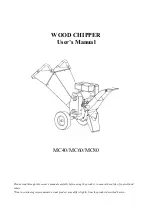
FRICK
®
POWERPAC
™
INSTALLATION
170.600-IOM (JUN 11)
Page 7
The unit may be top heavy. Lifting
operators must use extreme care to
check the level and stability of the
load before lifting the load more than a few inches. Impose
an imbalance by sequentially adding weight to each corner
and carefully observing the load reaction to make sure the
load does not shift. Balancing chains, cables or straps are
essential in both directions to prevent load shift and
instability during rigging. Call Johnson Controls-Frick
Engineering for an estimate of the location of the center
of gravity of the package if one is not given. The center
of gravity may NOT be located in the center of the package.
NOTES:
1. Reference OSHA Safety And Health Standards (29 CFR
1910), sections 1910.179 and 1910.184.
2. Hooks, chains, cables and spreader bars shall meet manu-
facturer’s recommendations and shall not be overloaded.
3. This unit shall be lifted using the four lifting lugs welded to
the base as shown above. Shackles and screw pins shall
be provided (by others) as shown in Figure 5 as minimum.
4. Spreader bars and balancing chains must be used to pre-
vent instability and damaging or straining system piping,
instrumentation or vessels.
5. Adjust cables or chains to ensure that the package (skid)
is stable and lifted in a level manner.
6. Lifting must be done by a qualified operator.
Figure 5
INSTALLATION
FOUNDATION
NOTE: Allow space for servicing at both ends of the unit.
A minimum of 24 inches (610 mm) is recommended.
T
he first requirement of the package chiller foundation is
that it must be able to support the weight of the package
including oil and refrigerant charge. Screw compressors are
capable of converting large quantities of shaft power into
gas compression in a relatively small space and a mass is
required to effectively dampen these relatively high fre-
quency vibrations.
Firmly anchoring the chiller package to a suitable founda-
tion by proper application of grout and elimination of piping
stress imposed on the package is the best insurance for
a trouble-free installation. Use only the certified general
arrangement drawings from Johnson Controls-Frick
to
determine the mounting locations and to allow for recom-
mended clearances around the unit for ease of operation
and servicing. Foundations must be in compliance with local
building codes and materials should be of industrial quality.
The floor shall be a minimum of 6 inches (152 mm) of re-
inforced concrete. Housekeeping pads are recommended.
Anchor bolts are required to tie the unit firmly to the floor.
Once the package is rigged into place (See HANDLING and
MOVING), it must be shimmed in order to level the unit.
The shims should be placed to position the package rails
one inch (25.4 mm) above the housekeeping pad to allow
space for grouting. An expansion-type epoxy grout must be
worked under all areas of the base, filling all voids. It should
be allowed to settle with a slight outward slope so oil and
water can run off of the base.
When installing on the upper floors of buildings, extra
precautions should be taken to prevent normal package
vibration from being transferred to the building structure.
It may be necessary to use rubber or spring isolators, or a
combination of both, to prevent the transmission of com-
pressor vibration directly to the structure. However, this may
increase package vibration levels because the compressor
is not in contact with any damping mass. Rubber or spring
pipe supports may be required to avoid exciting the building
structure at any pipe supports close to the chiller package.
It is best to employ a vibration expert in the design of a
proper mounting arrangement.
Proper foundations and proper installation methods are vital;
and even then, sound attenuation or noise curtains may be
required to reduce noise to desired levels.
For more detailed information on Screw Compressor Foun-
dations, please request Frick publication S70-210 IB.
HANDLING AND MOVING
Use a crane and rigging whenever the unit is moved.
DO
NOT USE A FORKLIFT. Refer to the engineering drawings
provided with the unit for shipping weight.
Spreader bars should be used on
both the length and width of the
package to prevent damage to the
package. CAUTION must also be used in locating the lifting
ring. Appropriate adjust ment in the lifting point should be
made to compensate for the center of gravity.
Figure 4








































